S90.09 Online Practice Questions and Answers
Currently, due to the increasing amount of concurrent access by service consumers, the runtime performance of both the Client and Vendor services has worsened and has therefore reduced their effectiveness as service composition members. Additionally, a review of the logic of both services has revealed that some of the business rules used by the Client and Vendor services are actually the same. What steps can be taken to improve performance and reduce redundant business rule logic?
A. The Rules Centralization pattern can be applied by extracting the business rule logic from the Client and Vendor services and placing it into a new Rules service, thereby reducing the redundancy of business rules logic. The Redundant Implementation pattern can then be applied to establish a scalable Rules service that is capable of supporting concurrent access from many service consumers.
B. The Redundant Implementation pattern can be applied to the Client and Vendor services, thereby establishing duplicate service implementations that can be accessed when a service reaches its runtime usage threshold. The Intermediate Routing pattern can be further applied to provide load balancing logic that can, at runtime, determine which of the redundant service implementations is the least busy for a given service consumer request.
C. The Rules Centralization pattern can be applied to isolate business rules logic into a central and reusable Rules service. Additionally, the Service Abstraction principle can be applied to hide the implementation details of new the Rules service.
D. None of the above.
Service A is a utility service that provides generic data access logic to a database that contains data that is periodically replicated from a shared database (1). Because the Standardized Service Contract principle was applied to the design of Service A, its service contract has been fully standardized.
The service architecture of Service A is being accessed by three service consumers. Service Consumer A accesses a component that is part of the Service A implementation by invoking it directly (2). Service Consumer B invokes Service A by accessing its service contract (3). Service Consumer C directly accesses the replicated database that is part of the Service A implementation (4).
You've been told that the shared database will soon be replaced with a new database product that will have new data models and new replication technology. How can the Service A architecture be changed to avoid negative impacts that may result from the replacement of the database and to establish a service architecture in which negative forms of coupling can be avoided in the future?
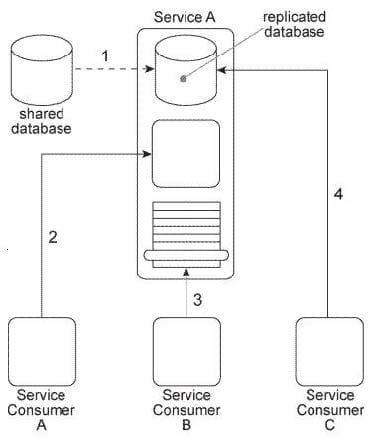
A. The Contract Centralization pattern can be applied to force all service consumers to access the Service A architecture via its published service contract. This will prevent negative forms of coupling that could lead to problems when the database is replaced. The Service Abstraction principle can then be applied to hide underlying service implementation details so that future service consumers cannot be designed to access any part of the underlying service implementation.
B. The Contract Centralization pattern can be applied to force Service Consumer C to access the Service A architecture via its published service contract. This will prevent Service Consumer A from being negatively impacted when the database is replaced in the future.
C. The Standardized Service Contract principle can be applied to force Service Consumer B to comply to the standardized service contract of Service A. As a result, the coupling between Service Consumer B and Service A is reduced. The Logic Centralization pattern can then be applied to position the logic provided by Service A as a primary access point for the database. As a result, the component within the Service A architecture abstracts the proprietary details of the database, thereby shielding Service Consumer A (and any future service consumers) from changes made to the database.
D. None of the above.
Service A is a task service that is required to carry out a series of updates to a set of databases in order to complete a task. To perform the database updates Service A must interact with three other services, each of which provides standardized data access capabilities.
Service A sends its first update request message to Service B (1), which then responds with a message containing a success or failure code (2). Service A then sends its second update request message to Service C (3), which also responds with a message containing a success or failure code (4). Finally, Service A sends a request message to Service D (5), which responds with its own message containing a success or failure code (6).

You've been asked to change this service composition architecture in order to fulfill a set of new requirements: First, if the database update performed by Service B fails, then it must be logged by Service
A. Secondly, if the database update performed by Service C fails, then a notification e-mail must be sent out to a human administrator. Third, if the database update performed by either Service C or Service D fails, then both of these updates must be reversed so that the respective databases are restored back to their original states. What steps can be taken to fulfill these requirements?
A. Service A is updated to perform a logging routine when Service A receives a response message from Service B containing a failure code. Service A is further updated to send an e-mail notification to a human administrator if Service A receives a response message from Service C containing a failure code. The Atomic Service Transaction pattern is applied so that Services A, C, and D are encompassed in the scope of a transaction that will guarantee that if the database updates performed by either Service C or Service D fails, then both updates will be rolled back.
B. The Compensating Service Transaction pattern is applied to Service B so that it invokes exception handling logic that logs failed database updates before responding with a failure code back to Service
A . Similarly, the Compensating Service Transaction pattern is applied to Service C so that it issues an e-mail notification to a human administrator when a database update fails. The Atomic Service Transaction pattern is applied so that Services A, C, and D are encompassed in the scope of a transaction that will guarantee that if the database updates performed by either Service C or Service D fails, then both updates will be rolled back. The Service Autonomy principle is further applied to Service A to ensure that it remains consistently available to carry out this sequence of actions.
C. The Atomic Service Transaction pattern is applied so that Services A, C, and D are encompassed in the scope of a transaction that will guarantee that if the database updates performed by either Service C or Service D fails, then both updates will be rolled back. The Compensating Service Transaction pattern is then applied to all services so that the scope of the compensating transaction includes the scope of the atomic transaction. The compensating exception logic that is added to Service D automatically invokes Service B to log the failure condition and Service C to issue the e-mail notification to the human administrator. This way, it is guaranteed that the compensating logic is always executed together with the atomic transaction logic.
D. None of the above.
Service A is an entity service that provides a Get capability that returns a data value that is frequently changed.
Service Consumer A invokes Service A in order to request this data value (1). For Service A to carry out this request, it must invoke Service B (2), a utility service that interacts (3.4) with the database in which the data value is stored. Regardless of whether the data value changed, Service B returns the latest value to Service A (5), and Service A returns the latest value to Service Consumer A (6).
The data value is changed when the legacy client program updates the database (7) When this change happens is not predictable. Note also that Service A and Service B are not always available at the same time.
Any time the data value changes. Service Consumer A needs to receive it as soon as possible. Therefore, Service Consumer A initiates the message exchange shown in the Figure several times a day. When it receives the same data value as before, the response from Service A is ignored. When Service A provides an updated data value, Service Consumer A can process it to carry out its task.

The current service composition architecture is using up too many resources due to the repeated invocation of Service A by Service Consumer A and the resulting message exchanges that occur with each invocation. What steps can be taken to solve this problem?
A. The Event-Driven Messaging pattern can be applied by establishing a subscriber- publisher relationship between Service A and Service B . This way, every time the data value is updated, an event is triggered and Service B, acting as the publisher, can notify Service A, which acts as the subscriber. The Asynchronous Queuing pattern can be applied between Service A and Service B so that the event notification message sent out by Service B will be received by Service A, even when Service A is unavailable.
B. The Event-Driven Messaging pattern can be applied by establishing a subscriber- publisher relationship between Service Consumer A and Service A . This way, every time the data value is updated, an event is triggered and Service A, acting as the publisher, can notify Service Consumer A, which acts as the subscriber. The Asynchronous Queuing pattern can be applied between Service Consumer A and Service A so that the event notification message sent out by Service A will be
received by Service Consumer A, even when Service Consumer A is unavailable.
C. The Asynchronous Queuing pattern can be applied so that messaging queues are established between Service A and Service B and between Service Consumer A and Service A . This way, messages are never lost due to the unavailability of Service A or Service B.
D. None of the above.
Service Consumer A sends a message to Service A (1), which then forwards the message to Service B (2). Service B forwards the message to Service C (3), which finally forwards the message to Service D (4).
Services A, B, and C each contain logic that reads the content of the message and, based on this content, determines which service to forward the message to. As a result, what is shown in the Figure is one of several possible runtime scenarios.
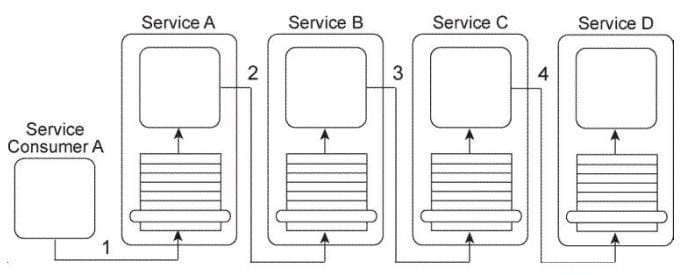
Currently, this service composition architecture is performing adequately, despite the number of services that can be involved in the transmission of one message. However, you are told that new logic is being added to Service A that will require it to compose one other service in order to retrieve new data at runtime that Service A will need access to in order to determine where to forward the message to. The involvement of the additional service will make the service composition too large and slow. What steps can be taken to improve the service composition architecture while still accommodating the new requirements and avoiding an increase in the amount of service composition members?
A. The Rules Centralization pattern can be applied to establish a centralized service that contains routing-related business rules. This new Rules service would replace Service B and could be accessed by Service A and Service C in order for Service A and Service C to determine where to forward a message to at runtime. The Service Composability principle can be further applied to ensure that all remaining services are designed as effective service composition participants.
B. The Asynchronous Queuing pattern can be applied together with the Rules Centralization pattern to establish a Rules service that encapsulates a messaging queue. This new Rules service would replace Service B and could be accessed by Service A and Service C in order for Service A and Service C to determine where to forward a message to at runtime. The Service Composability principle can be further applied to ensure that all remaining services are designed as effective service composition participants.
C. The Intermediate Routing pattern can be applied together with the Service Agent pattern by removing Service B or Service C from the service composition and replacing it with a service agent capable of intercepting and forwarding the message at runtime based on predefined routing logic. The Service Composability principle can be further applied to ensure that all remaining services are designed as effective service composition participants.
D. None of the above.
Service A has become increasingly difficult to maintain. Its core service logic has become bloated and convoluted because it has been updated numerous times during which additional functionality was added to interact with the database and the legacy system and to support interaction with Service Consumers A and B (via the two service contracts) as well as interaction directly with Service Consumer C.
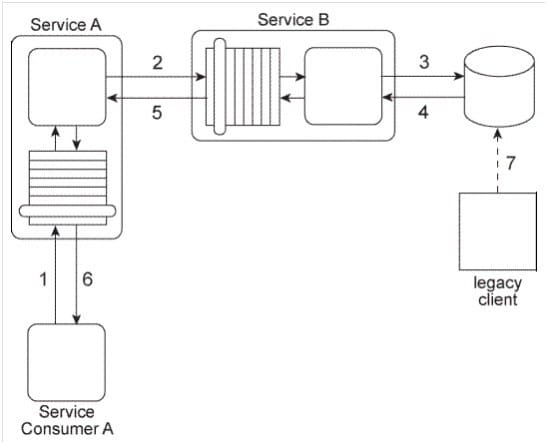
What steps can be taken to solve these problems and to prevent them from happening again in the future?
A. The Service Facade pattern can be applied to position a Facade component between the core service logic and the implementation resources (the database and the legacy system) and to also position a Facade component between the two service contracts and Service Consumers A and
B. The Official Endpoint pattern can be applied to limit access to Service A to one of its two published service contracts. The Service Loose Coupling principle can be applied so that Service Consumer C does not negatively couple itself directly to the core service logic of Service A . B. The Service Facade pattern can be applied to position a Facade component between the core service logic and the implementation resources (the database and the legacy system) and to position a faade component between the core service logic and the two service contracts. The Contract Centralization pattern can be applied to limit access to Service A to one of its two published service contracts. The Service Abstraction principle can be applied to hide the implementation details of Service A from service consumers.
C. The Service Faade pattern can be applied to position a Facade component between the core service logic and the two service contracts. The Contract Centralization pattern can be applied to limit access to Service A to one of its two published service contracts. The Service Loose Coupling principle can be applied so that Service Consumer C does not negatively couple itself directly to the core service logic of Service A .
D. None of the above.
It has been confirmed that Policy A and Policy B are, in fact, the same policy and that the security credential check performed by Service Agent B also needs to be carried out on messages sent to Service
B .
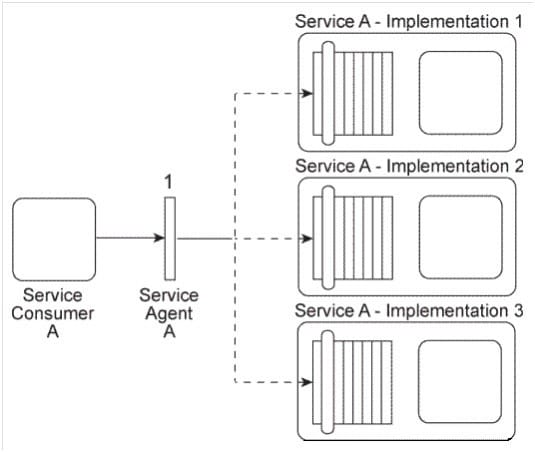
How can this service composition architecture be changed to reduce the redundancy of policy content and fulfill the new security requirement?
A. The Policy Centralization pattern can be applied so that Policy A and Policy B are combined into the same policy. The policy enforcement logic is removed from Service Agent C and Service Agent A is then used to enforce the policy for messages sent to Service A and Service B . Service Agent B can be used to perform the security credential check for Service A and Service B .
B. The Policy Centralization pattern can be applied so that Policy A and Policy B are combined into the same policy. The Service Agent pattern is then applied to introduce a new service agent (called Service Agent D) which carries out the validation and enforcement of Policy A and Policy B. Service Agent B can be moved so that it performs the security credential check for Service B, but not for Service A .
C. The Policy Centralization pattern can be applied so that Service Agent A is changed to enforce the policy for messages sent to Service A and Service B and to perform the security credential check for Service A and Service B .
D. None of the above.
Service Consumer A sends a message to Service A. There are currently three duplicate implementations of Service A (Implementation 1, Implementation 2, Implementation 3).
The message sent by Service Consumer A is intercepted by Service Agent A (1), which determines at runtime which implementation of Service A to forward the message to.
All three implementations of Service A reside on the same physical server.
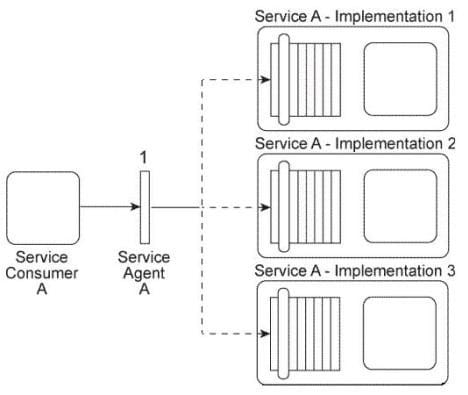
You are told that after Service A was deployed, each of its three implementations was claimed by a different IT department, which means each implementation of Service A has a different owner. You are informed that a new service capability will soon need to be added to Service A . This service capability will introduce new business logic specific to Service A as well as logic required to access a shared database. What steps can be taken to ensure that the service owners will each add the service capability in a consistent manner to their respective implementations of Service A?
A. The Contract Centralization pattern can be applied so that when the new service capability is added, the Service A service contract will become the primary contact point for Service A . This will avoid Service Consumer A or any other potential service consumer from being designed to access the shared database directly. The Service Abstraction principle can be applied to further hide the implementation details so that Service Consumer A and other service consumers are unaware of the fact that the shared database is being accessed.
B. The Legacy Wrapper pattern can be applied to establish a new wrapper utility service that will provide standardized data access service capabilities for the shared database. This will avoid Service A from having to access the shared database directly and will further support the application of the Service Loose Coupling principle between Service A and the new utility service. By abstracting the data access logic into the wrapper service, there is no need to add the new service capability to each implementation of Service A .
C. The Standardized Service Contract principle is applied to ensure that the new service capability is consistently added to the service contract of each implementation and that it extends the existing Service A service contract in a manner that is compliant with current design standards. The Service Loose Coupling principle is applied to ensure that the new service capability remains decoupled from the underlying logic and implementation so that Service Consumer A does not become indirectly coupled to any new logic or to the shared database.
D. None of the above.
You are told that in this service composition architecture, all four services are exchanging invoice-related data in an XML format. The services in Service Inventory A are standardized to use a specific XML schema for invoice data. Design standards were not applied to the service contracts used in Service Inventory B, which means that each service uses a different XML schema for the same kind of data. Database A and Database B can only accept data in the Comma Separated Value (CSV) format and therefore cannot accept XML formatted data. What steps can be taken to enable the planned data exchange between these four services?
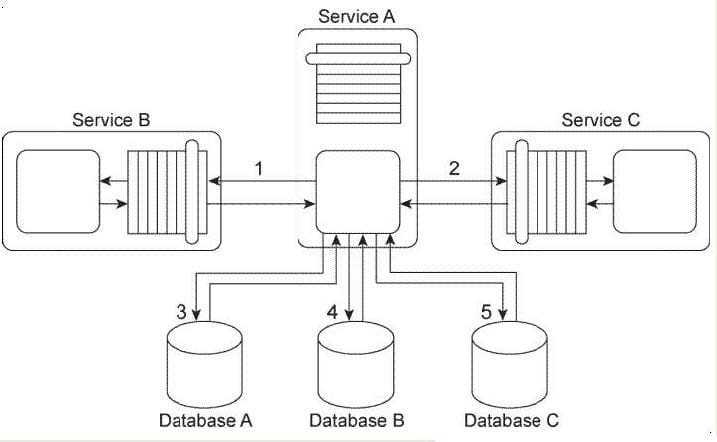
A. The Data Model Transformation pattern can be applied so that data model transformation logic is positioned between Service A and Service B, between Service A and Service C, and between Service C and Service D . The Data Format Transformation pattern can be applied so that data format transformation logic is positioned between the Service B logic and Database A and between the Service D logic and Database B.
B. The Data Model Transformation pattern can be applied so that data model transformation logic is positioned between Service A and Service C and between Service C and Service D . The Data Format Transformation pattern can be applied so that data format transformation logic is positioned between
the Service B logic and Database A and between the Service D logic and Database B.
C. The Data Model Transformation pattern can be applied so that data model transformation logic is positioned between Service A and Service C . The Protocol Bridging pattern can be applied so that protocol bridging logic is positioned between Service A and Service B and between the Service C and Service D . The Data Format Transformation pattern can be applied so that data format transformation logic is positioned between the Service B logic and Database A and between the Service D logic and Database B.
D. None of the above.
Service Consumer A sends a message with a business document to Service A (1), which writes the business document to Database A (2). Service A then forwards the business document to Service B (3), which writes the business document to Database B (4).
Service B then responds to Service A with a message containing a failure or success code (5) after which Service A responds to Service Consumer A with a message containing a failure or success code (6). Upon receiving the message, Service Consumer A updates a log table in Database B (7). The log entry is comprised of the entire business document. Database A is dedicated to the Service A service architecture and Database B is a shared database.
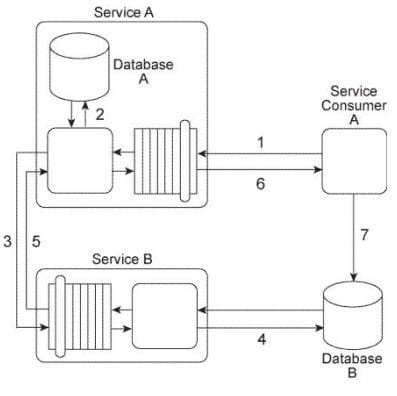
You are told that the database updates performed by Service A and Service B must be either both successful or they cannot happen at all. The database update performed by Service Consumer A must happen after it is given the outcome of the database updates performed by Service A and Service B . Given that Service Consumer A must also update Database B as part of this service composition architecture, how is it possible to fulfill these requirements?
A. The State Repository pattern can be applied so that Service A writes the business document data to a separate state database until it receives a response message from Service B . If the response message contains a success code, Service A writes the business document to Database A. If the response contains a failure code, Service A discards the data that was written to the state database.
B. The Service Data Replication pattern can be applied to Service Consumer A and Service B so that separate dedicated databases can be established allowing Service Consumer A to make updates independently of Service B . Service A is simply redesigned to not write the business document to Database A until after it receives a message containing a success code from Service B.
C. The Atomic Service Transaction pattern can be applied to encompass Service A, Service B and Service Consumer A. This will guarantee that all of the actions performed by the service composition participants will either be successful or will be rolled back if anyone is not successful.
D. None of the above.

